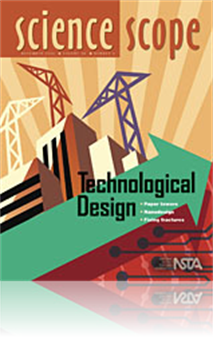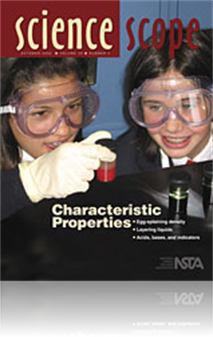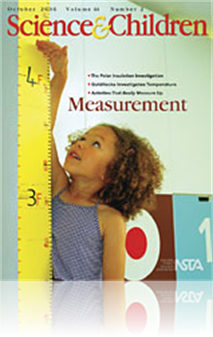All Resources
Journal Article
Star Wars: The name alone implies action, adventure, the vastness of space, alien creatures, and of course, who can forget light sabers? Since the Star Wars saga has entertained millions of people around the world for years, the author decided to...
Journal Article
Editor's Corner: Digital Frontiers
In 1960, JFK's rallying cry was "We stand at the edge of a New Frontier--the frontier of unfulfilled hopes and dreams." Our newest frontier is a digital one. It has changed the way we work, the way we shop, the way we communicate, and the way we get ...
Journal Article
Environmental Health Perspectives (EHP), a peer-reviewed environmental health research journal (published by the National Institute of Environmental Health Sciences, part of the National Institutes of Health,) provides the EHP Student Edition for ...
Journal Article
Shampoo, Soy Sauce, and the Prince's Pendant: Density for Middle-Level Students
This article describes a series of activities that are designed to clear up common student misconceptions regarding the difficult concepts of mass and density at the middle-level. Concept development, problem solving, design, measurement, and quantit...
Journal Article
A bowling alley isn’t just a hangout where adolescents eat pizza, drink soda, and socialize with their friends. It can be transformed into a giant physics laboratory where students study energy transfer and calculate factors affecting their game. T...
Journal Article
Teaching With Jazz: Using Multiple Cases to Teach Introductory Biology
Case studies challenge students to think, to process ideas at a higher and more complex cognitive level, and to experience science as a process rather than as a collection of facts. This article describes an introductory biology course sequence that...
Journal Article
Editor's Roundtable: Do state standardized science tests bring out the Chicken Little in us?
Recently, discussions of state standardized science tests have been spreading anxiety and dread in science department meetings and teacher lounges across the country. Before you run for cover in anticipation of the world crashing down around you, tak...
Journal Article
Sinking & Floating: A Graphical Representation of the Concept of Density
Density is a derived quantity that can be confusing for middle school students. Try using a graphical depiction of mass and volume to guide students in understanding and applying this concept. In this activity, students will collect various materials...
Journal Article
Science Shorts: Maximum Capacity
Many adults are more skilled in estimating “how long” and “how far” than in estimating other ways to measure—possibly because of the many instances of linear measurements in our everyday lives. Asking students to think about “how much it...
Journal Article
Kermit to Kermette? Does the Herbicide Atrazine Feminize Male Frogs?
This interrupted case study, developed for an honors seminar and a nonmajors chemistry course, is based on data taken from a series of published research articles. The case explores the unintended side effects of chemicals introduced into the enviro...
Journal Article
Kids who do hands-on science are eager to talk about, write about, and read about their experiences. Those of us who have tried it know that this is true, but it’s still one of the best-kept secrets of the world of education!...
Journal Article
Scope on the Skies: Tidal forces
Tidal forces are gravitational and vary between objects; in this case between the Moon and Earth. With an elliptical orbit, the Moon's gravitational influence, its tidal force, on the Earth varies with each apogee and perigee. At perigee, one would e...
Journal Article
Science and Social Justice: Making the Case for Case Studies
Incorporating social justice into science curricula can attract and maintain the interest of students who shy away from science because of a lack of immediate relevance or role models, and permits them to make connections between what they learn in t...
Journal Article
Be a Citizen Scientist! Celebrate Earth Science Week 2006
During Earth Science Week (October 8-14, 2006), millions of citizen scientists world-wide sampled groundwater, monitored weather, toured quarries, explored caves, prepared competition projects, and visited museums and science centers to learn about E...
Journal Article
At the beginning of the year in life science, students learn about science equipment use, metric manipulation, and cells. This pumpkin activity assesses all these areas while the students enjoy themselves doing a seasonal activity. In addition, it ev...
Journal Article
Science Sampler: Building student mental constructs of particle theory
The concept of particle theory is a basic idea in chemistry and physics and leads students to understand why solids, liquids, and gases have different properties although they are they are made of the same materials. Understanding particle theory hel...
Journal Article
Career of the Month: An Interview with Plant Geneticist John Stommel
As technology advances, so does the ability to better appreciate genetic diversity. Plant geneticists, such as John Stommel, use traditional research and biotechnology-based approaches to develop plants with improved quality, disease resistance, stre...
Journal Article
When Goldilocks finds three bowls of porridge at different temperatures in the three bears’ house, she accurately assess the situation and comes up with one of the most recognizable lines in children’s literature, “This porridge is too hot; thi...
Journal Article
Scope on Safety: (Lack of) safety in numbers?
What is the safe number of students for one teacher to teach? Like many issues in education, there is no one-size-fits-all answer. There are several factors that need to be considered when establishing the safe number of students to teach. In this mo...
Journal Article
One of the most powerful technology tools available to science teachers is often the least used. A course management system (CMS) is a web-based application that provides an online distance learning platform for teachers and students. CMS platforms s...
Journal Article
Science Sampler: Professor Color Presents... Acids, bases, and indicators
If you are looking for an exciting way to introduce a unit on acids, bases, and indicators, consider using the following demonstration, based on a chemistry presentation described by Hutton and Smith (1984), which has been adapted for use in the midd...
Journal Article
Activities that Really Measure Up
Linear measurement is more than just learning how to use a ruler. In the early grades, measurement activities develop students’ understanding of the properties of objects as well as what it means to measure objects. Hands-on activities can enable...
Journal Article
Editorial: Teaching With Cases -- Let Me Count the Ways
We're back, with yet another issue on the case study method of teaching. It's a method we think has expanding possibilities, especiallially in its application to science education. The use of stories to educate students has existed for thousands of...
Journal Article
Ask the Experts -- October 2006
In this month's Ask the Experts column, the following thought-provoking question is addressed: "Why did mother nature use uracil to replace thymine in mRNA (messenger ribonucleic acid)? What is the advantage of using U instead of T in the RNA?"...
Journal Article
Building Knowledge & Intrigue: Creating an Interactive Science Museum
The energy and enthusiasm shown by young students walking through the doors of an interactive science museum is difficult to surpass. The excitement and wonder that informal science education generates were instrumental in the author’s decision to ...
Journal Article
Science Sampler: Mapping variables
One of the biggest obstacles students encounter during the inquiry process is conducting valid investigations. Many students get caught up in the questions they have, the variety of materials they have access to, and the excitement of "doing" science...
Journal Article
Idea Bank: More than Multiple-Choice
Multiple-choice questions typically dominate tests in high school chemistry classes. The modification described in this article requires students to explain their reasoning behind each multiple-choice answer. This testing format demands more grading ...







